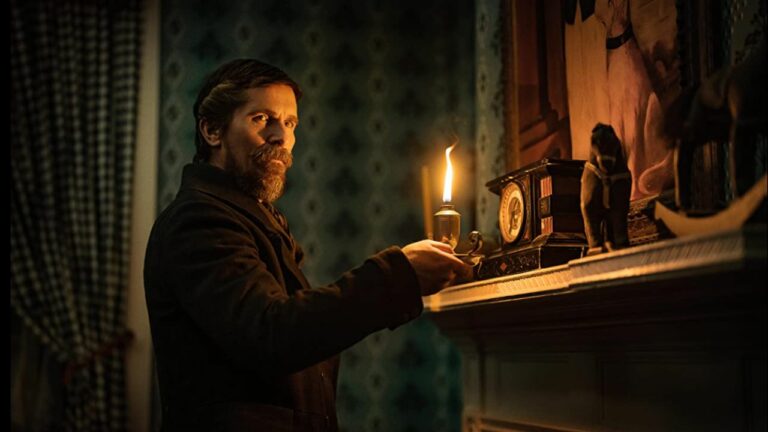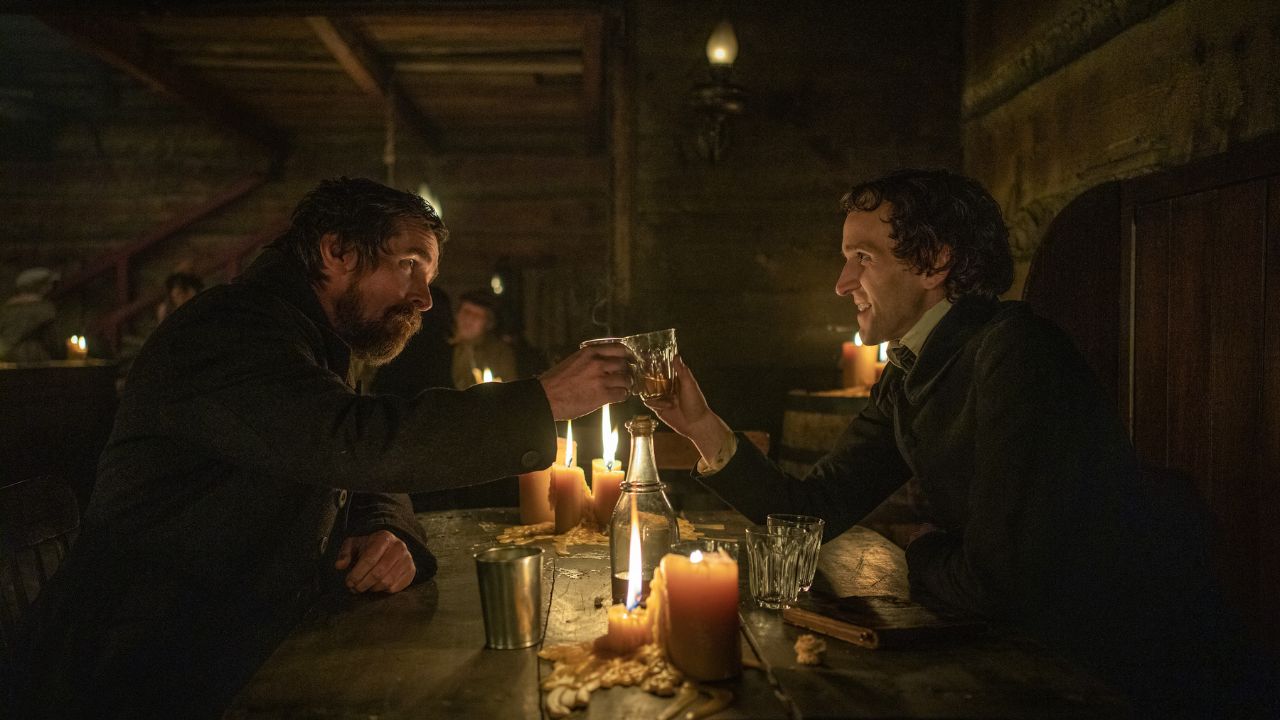A film with Edgar Allan Poe as an actual character is sure to be quite unique, eccentric, supernatural, and full of horror. The Pale Blue Eye ticks all those boxes. It’s no wonder that the ending is equally intriguing.
Netflix’s latest Gothic horror film has a premise that is not new to regular watchers of OTT content: a well-known detective/police officer is summoned by the authorities to investigate an absurd murder case.
In The Pale Blue Eye, retired detective Dr. Landor (Christian Bale) is appointed by the United States Military Academy to investigate a series of gruesome murders. One of the cadets, Edgar Allan Poe (Harry Melling), assists him in solving the mystery.
If you’ve not watched the film yet or are planning to watch it, this is your cue to stop reading right away. But don’t forget to come back to this article if you’ve any questions about the film. I’ve got you covered!
In the end, Landor comes to the conclusion that the murders were a result of the inhuman practices of a Satanic cult. However, Poe later comes to the conclusion that although the Satanists took the hearts out of the dead bodies, they didn’t kill them. The cadets were killed by Dr. Landor himself.
But he had his reasons, and pretty valid ones, if you ask me. Here’s everything you need to know about The Pale Blue Eye’s ending. Unlike our world-famous poet, my answer to all your questions will not be ‘Nevermore.’
Who is the real murderer?
Dr Landor killed two cadets – Leroy Fry and Randolph Ballinger as they had gang-raped his daughter, Mathilde a couple of years ago. The trauma led Mathilde to commit suicide, and Landor wanted to take revenge for his daughter’s rape and eventual death.
When Landor finds Mathilde after she was assaulted, he sees Leroy Fry’s locket in her hand which makes it clear to him that Fry was one of the men who raped her. Consequently, he realizes that the other two men are also cadets.

After Mathilde commits suicide due to her trauma, Landor decides to murder the three men who raped his daughter. He lures Leroy Fry to an isolated spot, where he hangs him. However, he is forced to leave the body and escape when he sees another cadet approaching them.
Though Landor kills Fry, he does not cut his heart out. After Fry’s body is discovered, the cadets ask Landor to take up the case. However, Landor was not done with his murders yet as there were two other men who raped Mathilde that night.
He finds out that Ballinger is one of them, and murders him. However, this time he is forced to cut his body and take his heart out to make it seem like Fry and Ballinger were murdered by the same Satanic cult who’ve been harvesting human hearts.
Before killing Ballinger, he tortures him until he reveals the name of the third cadet who raped Mattie that night – Stoddard. However, before he can kill Stoddard, he is forced to get hold of Lea and Artemus – who were stealing the hearts from the dead bodies.
Since both Lea and Artemus die in the process, the cadets remain under the impression that they are the ones who both killed the two victims and took their hearts. However, we’ve Edgar Allan Poe in this film, so there’s always another meaning to it all.
In the end, it is Poe who is able to bring the pieces of the puzzle together once again to figure out who the actual killer is.
Who stole the hearts and why?
Lea and Artemus Marquis cut Leroy Fry’s dead body and took out his heart for their Satanic ritual. However, they did not steal Ballinger’s heart, which was cut out by Landor to make everyone believe that the Satanists killed him.
Lea, Artemus and their mother, Julia, were all part of a Satanic cult and believed in communicating with the dead. Dr. Artemus, their father, was aware of this but didn’t say anything as the rituals were able to cure his daughter, Lea, from her seizures (or so he thought).
Though Landor killed Fry and Ballinger, he didn’t know who stole Fry’s heart, which is what he was investigating the entire time. In the climax, Lea plans to murder Poe in a similar manner and take out his heart.
However, Landor reaches in time to stop the ritual. In the chaos, the house is set on fire and both Lea and Artemus die in the fire.
What happens to Landor and Poe?
The Pale Blue Eye ends with Landor letting go of a piece of ribbon that belonged to Mattie, bidding her goodbye once and for all. This gesture is symbolic of him letting go of his grudge as well, as he is finally able to come to terms with his loss.
As far as what we see in the movie, Landor does not die. Since Poe decides not to reveal that Landor is the real killer, it seems like he continues to lead his life alone, like he was at the beginning of the film.

On the other hand, Poe says goodbye to Landor after letting him know he knows what he did. But he decides not to tell the academy the truth. In real-life, Poe quit the military academy in 1831, after which he went on to pursue his career in the literary world.
It is assumed that his time in the military and his experience in solving the murder with Landor will serve as inspiration for some of his darkest works in the future. Nothing is specified in the film about what happens next, but I guess we can assume this is what happens in the film too.
Is it a true story?
No, not at all. The Pale Blue Eye is not a true story, and is based on Louis Bayard’s 2003 novel of the same name. However, the character Poe refers to the real-life literary genius, Edgar Allan Poe.
If you’re familiar with Poe’s works, you’ll know that this is the kind of story he would actually like to write. So, it is not unnatural to think that being involved in such mysteries gave him the inspiration to write his Gothic horror stories.

However, as much as we like to think that the author of works such as The Raven and The Tell-Tale Heart actually helped solve a real-life murder mystery, it is not true. But the film is full of easter eggs to satisfy your literary soul. For example, Poe refers to Lea as Laenor in the film, which is also a character in his most famous poem of all time, The Raven.
Landor’s character is also reminiscent of Poe’s popular fictional sleuth, C. Auguste Dupin. Dupin is known to follow what Poe himself termed as “ratiocination” – combining his intellect with imagination and thinking like the criminal. In the film, Landor and Poe follow a similar technique as they try to dissect the killer’s thoughts and ideas.
Having said all that, it is true that Poe was at West Point during the early days of his life, where he trained as a cadet for a few years. So, the premise of the film is not fictional. But again, there’s no account of him being involved in any mysterious murder case.
It is, however, implied that Poe was inspired by the murders at West Point to write his stories and poems, which later made him world famous. In fact, he is seen writing poems and being an avid lover of literature in the film, which is quite accurate as well. So the incident may not be real but it is inspired by a real-time in Poe’s life.
About The Pale Blue Eye
The Pale Blue Eye is a 2022 American mystery thriller film written and directed by Scott Cooper. The movie is an adaption of Louis Bayard’s 2003 novel of the same name.
Set in the 1830s, it follows Christian Bale’s, Augustus Landor investigating a series of gruesome murders at West Point Military Academy with the assistance of a cadet named Edgar Allan Poe.
The film features an ensemble cast of Christian Bale, Harry Melling, Gillian Anderson, Lucy Boynton, Charlotte Gainsbourg, Toby Jones, Harry Lawtey, Simon Mcburney, Timothy Spall, and Robert Duvall.









No Comments on The Pale Blue Eye’s Unexpected Ending Explained